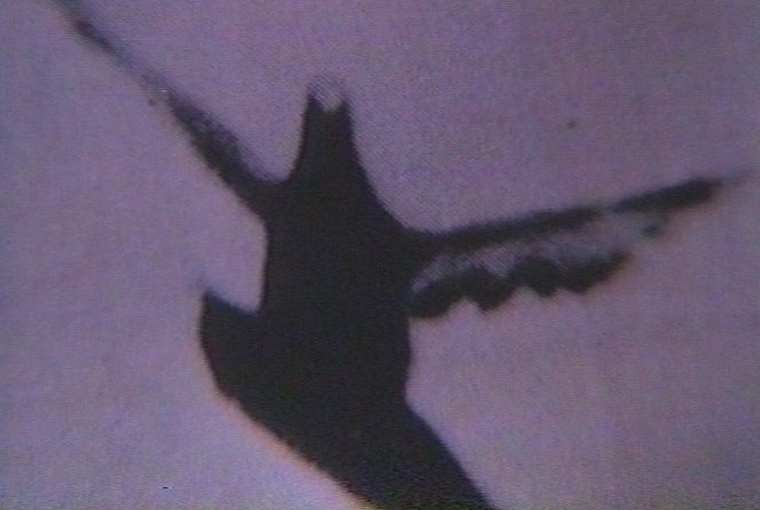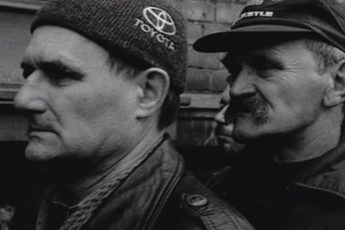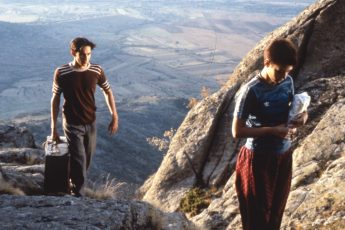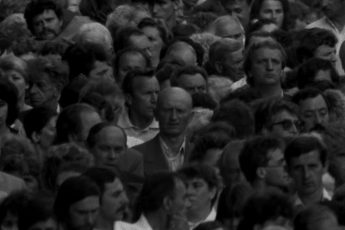Poetry and Cinematic Memory
Aleksandr Balagura’s Antologion (Ukrainian Film) (1996)
Vol. 105 (May 2020) by Anna Doyle
Antologion”, which means “harvest, crown of flowers; harvest of poetic passages” or even “collection of the lives of saints, poetic pieces”, is the title of Balagura’s 1996 homage to the centenary of cinema. His work is both an editing film, a genre established in 1920s silent cinema, and a found-footage film, a technique that first appeared in film with surrealism. The film was initially imagined as silent, but Balagura later added music by Avet Terterian and Valentin Silvestrov. The film assembles different images of Ukrainian poetic cinema into a series of glimpses into the history of Ukrainian cinema without a woven narrative thread. It is not an intimate film, but it addresses a knowledgeable collective spectator, capable of reading through the references to Ukrainian films and of reflecting upon these. Found-footage here gives new life to filmmakers who had sometimes been “buried” by critics (Leonid Bykov, Leonid Osyka, Ivan Kavaleridze, Leonid Mogilevskiy), as well as more well-known ones (Alexander Dovzhenko, Sergei Paradjanov, Dziga Vertov). The great Ukrainian actor Ivan Mikolaychuk also appears throughout Antologion in his different film roles. The film thus creates a memory of mythic Ukrainian poetic cinema, rather than simply preserving it. However, Antologion plays with the frailty of this memory and this is reflected within the archival essence of the cinematic image of found-footage.
Images from eighteen films from the Soviet era produced in Ukraine are intertwined in this “Ukrainian film”. The film is dedicated to these filmmakers, “to the happy ones who have gone”. If we think of the film as a collection of the lives of saints, the film appears to be a multiple hagiography of the iconic figures of Ukrainian cinema, one of whom, namely Paradjanov, himself produced a filmic hagiography. Sayat-Nova, and the passages of Sayat-Nova in Balagura’s film, appear as a mise en abyme of hagiography itself. Yet ‘the happy ones’ are not only Ukrainian filmmakers. The statement also refers to the Ukrainian people filmed here through national customs and folklore, in the form of a folk innocence that differs from the portrayal of an aggressive revolutionary working-class in say Eisenstein films. Images of the Ukrainian people gathering and isolating alternate with images of the sea, of trees, of objects falling and moving, creating an organic link between the characters and their environment. The films cited share similarities (a questioning of Ukrainian identity, a return to traditions) as well as differences (whereas Paradjanov criticizes socialist realism, Dovzhenko still seems inspired by it, while Dziga Vertov claims cinema to have a role in social change). Paradjanov loves to show the excess and color of the region he films, whereas Dovzhenko and Osyka prefer black-and-white and peasant simplicity.
We see famous images from Soviet cinema intertwining: the famous last scene of Shadows of Forgotten Ancestors, scenes from the beginning of Sayat-Nova, the dream sequence of Paradjanov’s experimental Kiev Frescoes, the famous dancing ballad of Dovzhenko’s Earth, scenes from Leonid Osyka’s Stone Cross, a moving story of Ukrainian attachment to peasant life. A series of shot/reverse shots of eyes looking at the spectator puts us in a self-reflexive mood. Gestures, sport, the ideal Soviet body or Nazi diving competitions express the corporeality of totalitarian ideology. Gunshots are juxtaposed with a picture of a naked woman. Images of harvest demonstrate the human attachment to the soil. Folk dances are followed by images of men and women in factories, and of automatic labor, two different visions of the Ukrainian people: the film enacts the dictum of ‘socialism in content and nationalism in form’. These images are intertwined through motion connectors and symbolic connectors that help create an organic and meaningful relationship between images.
The film also shows documentary images. These include images of famous cosmonauts Gagarin and Leonov, recalling Artavazd Pelechian’s quest for the stars in Our Century. Whereas in Artavazd Pelechian’s film, Gagarin’s take-off appears as an internationalist symbol of the Soviet desire to go beyond national borders, here it appears as a figure of a difficult relationship between regional (Ukrainian) belonging and Soviet pride. Assembling Gagarin’s take-off with Dovzhenko’s Earth creates a game between telluric and astral poetics, a dialectic between attachment to the Ukrainian earth and belonging to a Soviet power that seems to want to detach or distance itself from earth. We also see images from Nazi Germany and Nazi troops in Ukraine – images of the historical context out of which Ukrainian cinema was born. These documentary images contrast with the poetic images of Ukrainian cinema. Nazi troops in Ukraine recall a realistic historical décor, a history of progress and catastrophe, a history Ukrainian poetic cinema ignored in favor of a more anti-dialectical exploration of archaic reality with poetic themes.
Images of Dovzhenko’s and Paradjanov’s cinema and other Ukrainian films are summoned in the form of a self-reflection on Ukrainian cinema and more specifically the “poetic Kiev school”. A rhapsody in classical music is originally a composition using regional, folklore or traditional themes to it. The rhapsodic tone of Antologion comes from the choice of images that are specifically regional, drawn from Ukrainian folklore and traditions.
The Kiev school developed in Ukraine in the 1960s and 1970s. The terms “Kiev school”, “poetic school” and “pictorial school” were not invented by critics but by the directors in question. Even if Paradjanov was not Ukrainian, he is a central figure of this school because he directed The Shadows of Forgotten Ancestors, a film made in Ukraine about a Ukrainian ethnic group, the Hutsuls. There is even a statue of Paradjanov opposite to that of Dovzhenko in the garden of the Dovzhenko Studios production company. The common point of these filmmakers is not so much their nationality as their common interest in national cultures, especially folk traditions and national myths, as well as their taste for stylistic experimentation. The fusion of national expression and poetic style thus defines this school, yet the directors do not necessarily identify with the respective groups.1 During the Thaw, filmmakers from non-Russian Soviet republics tried to develop their own mode of cinematic expression and to extend the narrative limits of cinema. The critic Jeanne Vronskaya describes this “image cinema” as a school that makes films typically composed of “a short story, focusing on folklore and ethnography, exotic motifs and generally on the visual elements of cinema”2, rather than narrative elements. She adds that the films resemble “a beautiful painting or an old drawing” rather than the dramatic narrative of classical cinema. To this visual aspect can be added the importance of sound and editing, which produce new poetic effects rather than merely constituting an accompaniment to the narrative.
This notion of poetic cinema, cinema poetry, or cine-poem, which was appropriated by Pasolini, returns to the fundamental theory of literary critic Viktor Shklovsky in his 1927 essay ‘Poetry and Prose in Cinematography’. “The film without narration is the poetic film,” he says in Art as Process3. The narration is minor compared to the play of rhythm and style at work in the cinematography of poems. What distinguishes poetry from prose are various geometric tools, a series of arbitrary semantic resolutions that can be replaced by pure forms and geometric shapes. The use of these ‘geometric tools’ operates in parallel to those used in poetry.4 Repetition, parallelism and visual rhyme all make up the structure of the film. Just as processes such as alliteration, assonance, rhyme, and repetition are used in poetry, cinema will use its own language mobilizing the work of camera movements, editing, and sound accompaniment.
In Antologion, the use of found-footage, or re-photographed film, plays with memory and its rustiness. It is a game of difference and repetition, the original image is altered here, losing or redefining its authenticity (as is done in the art of quotation in Ezra Pound’s poetry, a point of reference for Balagura). Found-footage, reassembled decontextualized footage, is a way to create an alternative way of seeing the history of cinema, a way of creating the past rather than preserving it. “Archivization produces as much as it records the event,” says Derrida.5 Derrida sees the archive as a trace, and this trace can be erased, like “ash”, leaving no memory, but the destruction of it. It is this injunction to amnesia or hypomnesia that makes us speak of “archive fever”. In Balagura’s work, making a trace and creating a memory is also failing to recollect the narrative link that ties Ukrainian cinema and Ukrainian history together. However, it seems that Balagura is against a cinema of furtivity, of what Dominique Paini calls the cinema that relies on “incessant forgetfulness” – “twenty-four or twenty-five photograms disappearing and being forgotten each second. […] Filmmakers would like to find a new site today for their ideas that he created to remain”.6 Balagura is one of these filmmakers that find a site for memory to remain despite its forgetfulness through the incessant scrolling of photograms.
In Aleksandr Balagura’s film Antalogion, the camera relies on the fragility of the cinematic image. We see an image of a “Pigeon flying” by Eadweard Muybridge. Balagura calls it “the soul of cinema”. With these images, the camera reveals the optical unconscious, to use Walter Benjamin’s terms, as it exposes the unconscious of Ukrainian cinema itself. The camera “introduces us to unconscious optics as does psychoanalysis to unconscious impulses,” says Walter Benjamin.7 Yet, it is less furtivity of movement that interests Balagura in chronophotography than the immortality of Muybridge’s characters, which stand like Platonic ideas or eternal inhabitants of a Golden Age of cinema before the arrival of linear time with the Lumières. The signature shot of Antalogion is the pigeon whose flapping wing movement is deconstructed like a flickering image. As Christian Lebrat shows in Radical Cinema,8 wing flapping and experimental cinema have a long story together. The flight of a bird and the flapping of wings is a motif of the cinema of the first experimenters. The animal, as Muybridge and Étienne-Jules Marey had predicted, essentializes movement. Marey’s chronophotographs of a gull’s wingbeat link the figurative image of the bird with the abstract beat of the photogram. The metaphor of the bird in cinema seems to be a metaphor for the origins of cinema but also for the death of cinema in its narrative dimension and its rebirth in another pre-verbal form. The bird’s movements are a metaphor for a flickering gaze, mourning the rhythmic beat of the image, between appearance and disappearance, firmness and fragility.
In Balagura’s film, Ukrainian cinema is not seen in its present form, but in a postmodern nostalgia for the Golden Age of Ukrainian cinema, but also for the early beginnings of cinema, that is chronophotography. The relation between poetry and memory are explored through the archival medium. The interplay between memory and its reconstruction, references to the fragility and durability of archival images, the regional identification of Ukrainian cinema and poetic experimentation, all characterize Balgura’s film. Although taken from different parts of film, the poetic images all appear to be questioning the same myth, “the myth of lost paradise”, and the need to sacrifice it. Perhaps this sacrifice of a lost paradise, the paradise portrayed in the mythical images of Ukrainian cinema, away from totalitarianism, is implemented by the making of this film. The film sacrifices and resurrects images for the spectator to reconstruct Ukrainian identity and its version of national memory.
References
- 1.James Steffen, The Cinema of Sergei Paradjanov, Madison, University of Wisconsin Press, 2013 p.18.
- 2.Jeanne Vronskaya in James Steffen, The Cinema of Sergei Paradjanov, Madison, University of Wisconsin Press, 2013 p.18.
- 3.Victor Shklovsky L’Art comme procédé, dans Théorie de la littérature, éd. et trad. Tzvetan Todorov, préf. Roman Jakobson, Paris, Éditions du Seuil, 1965, p. 83.
- 4.James Steffen, The Cinema of Sergei Paradjanov, Madison, University of Wisconsin Press, 2013, p.19.
- 5.Jacques Derrida, Archive Fever: A Freudian Impression, trans. Eric Prenowitz (Chicago: University of Chicago Press, 1996), p.16–17.
- 6.Dominique Paini in Raymond Bellour, La querelle des dispositifs, cinéma, installations, expositions, Paris, P.O.L, 2012 p.29.
- 7.Walter Benjamin, The Work of Art in the Age of Mechanical Reproduction (1936), repr. in Hannah Arendt (ed.), Illuminations, 1968 sct. 13.
- 8.Christian Lebrat, Cinema Radical, Paris, Paris Experimental, 2008 p. 125.




Leave a Comment